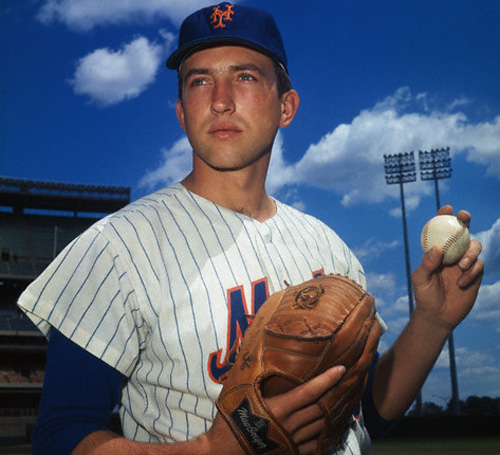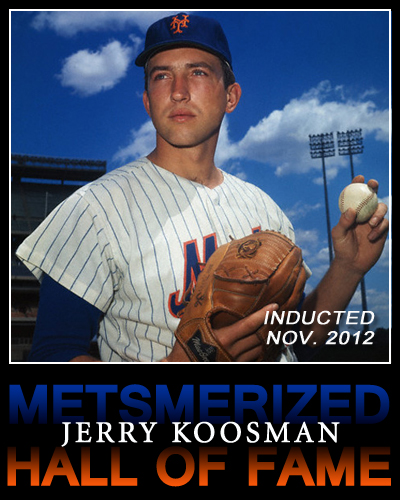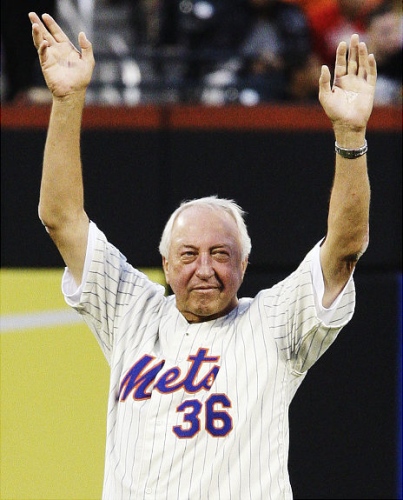Last week Mets Merized Online rolled out our Metsmerized Hall of Fame. We will be enshrining one player each week until our five founding members are all unveiled. So far, we’ve selected Tom Seaver in week one, and Keith Hernandez in week two. After our five Founding Members are selected, we will ask you, our readers, to cast your ballot for who should be selected for enshrinement in 2013. Learn more by visiting our Metsmerized Hall of Fame. It’s with great pleasure that we announce our third founding member of the Metsmerized Hall of Fame…
Out Of The Shadows: Jerry Koosman
There have been many great players who lived in the shadow of an even greater teammate. Lou Gehrig had Babe Ruth. Don Drysdale had Sandy Koufax. Jeff Kent had Barry Bonds. Jerry Koosman had Tom Seaver.
Along with Seaver, Koosman played in a time when pitching dominated the game. It seemed like every team had a legitimate ace. However, no team had a 1-2 righty-lefty punch like the Mets. While Tom Seaver turned the Mets into a legitimate team, it was with Koosman pitching the next game that turned the Mets into a pitching powerhouse.
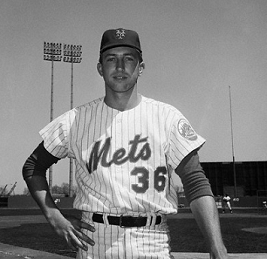 In the mid 1960’s, a young man stationed at Fort Bliss, TX saw one of his fellow soldiers pitching. The man wrote a letter to his father who worked as an usher at Shea Stadium and told his dad about this ‘guy who looks pretty good.’ The usher told some people in the Mets brass about this young kid named Jerry Koosman. Eventually, the Mets gambled and signed the young LHP after being discharged from the Army.
In the mid 1960’s, a young man stationed at Fort Bliss, TX saw one of his fellow soldiers pitching. The man wrote a letter to his father who worked as an usher at Shea Stadium and told his dad about this ‘guy who looks pretty good.’ The usher told some people in the Mets brass about this young kid named Jerry Koosman. Eventually, the Mets gambled and signed the young LHP after being discharged from the Army.
The relationship between Jerry and the Mets got off to a rocky start. En route to his first spring training his car broke down. Standing on the side of the road, broke and broken down, Koosman called the Mets who regrettably wired money to this kid. The always frugal Mets were already disenchanted with having to shell out a few bucks to a nobody. They were ready to give up on him when Joe McDonald had a different idea. He suggested to keep Koosman until he got his first paycheck so they could at least see him pitch. After his first paycheck, they planned to dock him the money they forked over for a tow truck.
In 1968, rookie Koosman burst onto the scene. The Mets won 73 games that season. Koosman won 19 of them. He also whiffed 178 and posted a 2.08 ERA to go along with 7 shut-outs. The wins, shutouts and ERA were Mets records, set the previous season by teammate Tom Seaver. The 7 shut-outs stood as the team record until 1985. On July 9 of that season, the Mets rookie appeared in his first of 2 consecutive All-Star games. In the only 1-0 game in All-Star history, Koosman struck out Carl Yastrzemski to record the save.
At the end of the year, Koosman was in the shadows. He finished 2nd in Rookie of the Year voting, losing out to Reds catcher and future Hall of Famer Johnny Bench.
As the Mets found themselves in their first pennant race ever the following season, Jerry was struggling. On August 12, 1969, the Mets lost to Houston 9-8. Kooz gave up 6 ER in 6 1/3 IP. He dropped to 9-8 and with 6 weeks left the Mets dropped to 9 games back.
Koosman then turned it up a notch. He displayed for the first time that he was a ‘Big Game Pitcher.’ As the Miracle took form and the Mets chased down the heavily favored Cubs, Jerry went 8-1. He finished the season 17-9 with 180 strikeouts and a 2.28 ERA.
In Game 1 of the World Series, the Orioles showed why they were heavily favored over the Amazins. Mets ace and 25 game winner Tom Seaver didn’t make it past the 5th. He allowed 4 ER’s and 6 hits. Mets faithful began wondering if reality was setting in.
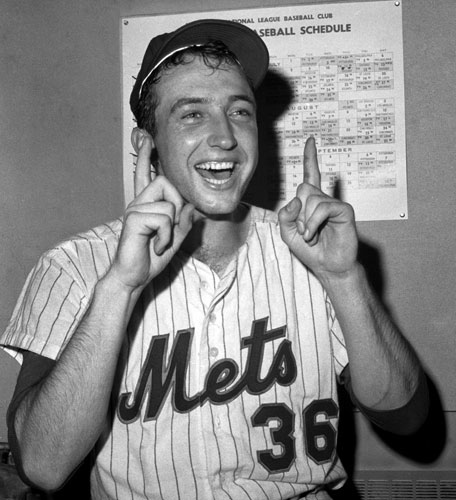 Under the brightest spotlight in Baseball, Jerry yet again shone. In game 2, Koosman took the mound. And took control. When the Mets NEEDED a victory, he stepped up. The big bats like Frank and Brooks Robinson, Paul Blair and Boog Powell went silent. Koosman conjured up images of Don Larsen as he took a no-hitter into the 6th. Jerry got the win, allowing just 2 hits in 8 2/3. The series was now tied 1-1 and went back to Shea.
Under the brightest spotlight in Baseball, Jerry yet again shone. In game 2, Koosman took the mound. And took control. When the Mets NEEDED a victory, he stepped up. The big bats like Frank and Brooks Robinson, Paul Blair and Boog Powell went silent. Koosman conjured up images of Don Larsen as he took a no-hitter into the 6th. Jerry got the win, allowing just 2 hits in 8 2/3. The series was now tied 1-1 and went back to Shea.
A few days later, Koosman took the mound again. With the Mets up 3-1 and just 27 outs shy of a championship, knowing a loss would send the series back to Baltimore, Koosman struggled early, allowing a couple of HR’s. But with the Mets trailing 3-0 early, he didn’t crack. He settled down and took control of the game. The Mets won 5-3 and The Miracle came to fruition. Koosman pitched a complete game, allowing 5 hits and 3 ER.
The Mets won 4 games to 1. Koosman was the winning pitcher in 2 of them.
In 1971 and 1972, Koosman struggled. He battled arm problems in 71 and went just 6-11. He struggled again in 72, posting a record of 11-12 and his ERA of 4.14 was over a run higher than his career average.
1973 saw the Mets in the midst of one of the tightest pennant races ever. On August 17th, the Mets were only 7 ½ back, but were in last place and 13 games under 500. As he did 4 years earlier, Koosman performed brilliantly down the stretch. As the Mets ended up eking out a division title, Jerry did not lose. He went 5-0 and when the Mets needed him the most, he tossed 31 2/3 consecutive scoreless innings, a record that stood for almost 40 years until RA Dickey in 2012.
In the 73 NLCS, it was Koosman who was on the mound for Game 3, a game better remembered for the altercation between Buddy Harrelson and Pete Rose.
In game 5 of the Fall Classic, he outpitched another great LHP, Vida Blue. He allowed just 3 hits and no earned runs through 6 1/3 innings pitched. The Mets won the game and with Koosman’s victory, the Mets were just 1 win away from their 2nd championship. As Koosman walked off the mound, there would not be another World Series game played at Shea for 13 years.
In 1976, Koosman finally became a 20 game winner. He went 21-10 with 200 K’s and a 2.69 ERA. In spite of his stellar numbers, he was again in the shadows. He finished 2nd in the Cy Young Award to Randy Jones.
Arguably one of the top lefties in the game, Koosman could have written his own ticket. He could have gone to another team where he’d have been the ace of the staff. And playing for a different club he could have more run support than the light hitting Mets and increased his win total. But Koosman chose to stay with the team he loved…for a while.
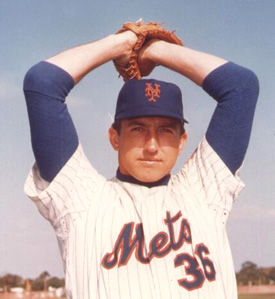
By the late 70’s, M. Donald Grant was like a sniper with a rifle in a bell tower, slowly picking out his next victim. As Jerry Koosman stood on the mound he was surrounded by new faces, strange faces. Gone were his friends like Rusty and Cleon and Buddy. When he looked into the bullpen he didn’t see Tug McGraw. His best friend, Tom Seaver, was not in the dugout. When he’d look in at home plate it was not Jerry Grote putting down any fingers.
With the trade of Tom Seaver, Koosman became the de facto ace of the staff. But being the ace of a staff on the worst hitting team in the league is not appealing. In 1977 and 78, Kooz posted a respectable ERA of 3.62 and fanned 352 while walking 165. However, run support was non-existent. In spite of solid stats, Koosman went just 11-35.
Seeing the writing on the wall and realizing the Mets were going nowhere, the 34 year old demanded to be traded. The Appleton, MN native was sent to the Twins for young pitchers Greg Field and Jesse Orosco.
Over the next 2 seasons, the aging lefty won 36 games.
For a team that is best known for pitching, Koosman remains near the top of every Mets category. He is 3rd wins (140) and strikeouts (1799), 2nd in Shutouts (26), IP (2544), starts (346) and 5th in ERA (3.09).
During his time with Mets he was in the Top 10 in the NL in ERA five times, shutouts four times, and strikeouts six times.
Jerry Koosman was the best #2 in the game. He is the top LHP in Mets history. Buddy Harrelson once stated that in a must-win game, he’d go with Koosman every time. Of the 7 games the Mets won in the 69 and 73 World Series, Koosman won 3 of them posting a 2.39 ERA and allowing just 16 hits in 26 1/3 IP. Although he pitched in the shadow of Tom Seaver, in spite of the fact that he lost the Rookie of the Year to Johnny Bench, even though he was runner-up for the Cy Young Award in 1976 to Randy Jones, it was in the post-season where Jerry Koosman emerged from the shadows.
Congratulations to lefthander Jerry Koosman, the third Mets player to be enshrined into the…

